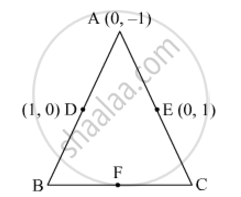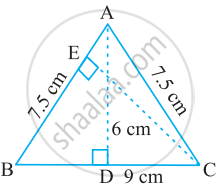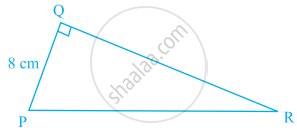Advertisements
Advertisements
प्रश्न
Find the value of k so that the area of the triangle with vertices A (k+1, 1), B(4, -3) and C(7, -k) is 6 square units
उत्तर
`"Let" A(x_1,y_1) = A(k+1,1) , B(x_2,y_2)= B (4,-3) and C(x_3,y_3) = C(7,-k) now`
`"Area "(Δ ABC) = 1/2 [x_1 (y_2-y_3) + x_2 (y_3-y_1) +x_3(y_1-y_2)}`
`⇒ 6=1/2 [(k+1) (-3+k)+4(-k-1) +7(1+3)]`
`⇒6=1/2[k^2 -2k-3-4k-4+28]`
`⇒ k^2-6k+9=0`
`⇒(k-3)^2 = 0⇒k=3`
Hence , k=3
APPEARS IN
संबंधित प्रश्न
In Fig. 6, ABC is a triangle coordinates of whose vertex A are (0, −1). D and E respectively are the mid-points of the sides AB and AC and their coordinates are (1, 0) and (0, 1) respectively. If F is the mid-point of BC, find the areas of ∆ABC and ∆DEF.

Find the area of a triangle whose vertices are A(3, 2), B (11, 8) and C(8, 12).
ΔABC is isosceles with AB = AC = 7.5 cm and BC = 9 cm (see the given figure). The height AD from A to BC, is 6 cm. Find the area of ΔABC. What will be the height from C to AB i.e., CE?

Show that the points are the vertices of an isosceles right triangle.
Show that the points A (3,1) , B (0,-2) , C(1,1) and D (4,4) are the vertices of parallelogram ABCD.
Show that the following points are collinear:
A(8,1), B(3, -4) and C(2, -5)
If the area of triangle ABC formed by A(x, y), B(1, 2) and C(2, 1) is 6 square units, then prove that x + y = 15 ?
Show that the ∆ABC is an isosceles triangle if the determinant
Δ = `[(1, 1, 1),(1 + cos"A", 1 + cos"B", 1 + cos"C"),(cos^2"A" + cos"A", cos^2"B" + cos"B", cos^2"C" + cos"C")]` = 0
The area of a triangle with vertices (a, b + c), (b, c + a) and (c, a + b) is ______.
Area of a triangle PQR right-angled at Q is 60 cm2 in the figure. If the smallest side is 8 cm long, find the length of the other two sides.

